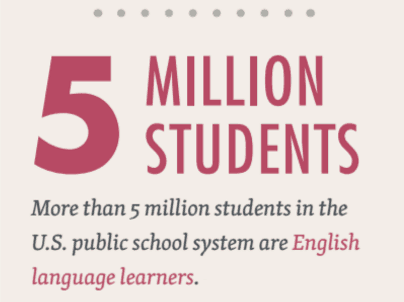4 Parent Engagement Strategies for English Language Learners

Meriwynn Mansori, Manager of Curriculum, VIF International Education
Research shows that parental engagement pays off for all students. Regardless of family income or background, students with engaged parents are more likely to:
- Earn higher grades and test scores, and enroll in higher-level programs.
- Be promoted, pass their classes and earn credits. Attend school regularly.
- Have better social skills, show improved behavior and adapt well to school.
- Graduate and go on to postsecondary education.
In some U.S. states, one in four students is an English language learner. This statistic reminds us how critical it is to redouble efforts to ensure the success of all our students and to think creatively about ways to collaborate with all parents. Research indicates that when parents of English language learners have more say in their child’s education, student outcomes improve.
For educators, engagement with parents of English language learners may look different than it does in traditional classroom settings because of perceptions around language and cultural differences. English as a second language (ESL) teachers must embrace opportunities to create inviting environments that allow parents to participate in their children’s education in diverse ways. In the words of one ESL teacher, “It’s not just about fundraising and showing up to parent nights.”

Below are four suggestions for inviting collaboration and engagement with the families of English language learners.
1. Adopt a growth mindset
Rethinking your own mindset and the ways you view the circumstances of English language learners and their families is an important start. Mindset author Carol Dweck explains, “When people… change to a growth mindset, they change from a judge-and-be-judged framework to a learn-and-help- learn framework. Their commitment is to growth, and growth takes plenty of time, effort and mutual support.” ESL educators and parents of English language learners share a common goal: their students’ success. Adopting a growth mindset is key to achieving this goal.
2. Honor cultural differences
When you get to know the parents of students and learn about and invite cultural diversity into your classroom, you send the powerful message to both students and their families that they are in a safe space in which their cultures are respected and valued. English language learners’ diverse cultural backgrounds provide rich fodder for culturally responsive teaching. At the same time, however, cultural differences can pose challenges. Different cultural norms may influence parent expectations about their roles in their children’s education. Honor these differences and forge strong relationships with the families of English language learners by:
- Getting to know students’ parents.
- Learning about the different cultural norms of your students.
- Directly communicating to parents your support for their children and respect for their cultures.
3. Don’t fret over language differences
As students acquire English as a second language, they are developing the competitive advantage of being bilingual. Nevertheless, if you don’t speak your students’ home languages, it’s easy to view communication with their parents as a major challenge. Address that challenge to communicate effectively with parents by:
- Using straightforward language and avoiding jargon.
- Inviting native-language speakers to join discussions on grading, testing and report cards.
- Arranging student-led conferences.
- Using community or school resources to support translation needs.
- Giving hands-on demos at back-to-school nights.
- Encouraging L1 reading in home settings to promote first language literacy and second language acquisition.
4. Be creative about logistics
Child care issues, transportation challenges and work schedules can all get in the way of arranging meetings with the parents of English language learners. A little flexibility and creativity will help in finding ways to connect with parents in person or virtually. Some ideas for solving logistical issues include:
- Planning ahead when possible.
- Meeting parents at their home or workplace.
- Engaging parents virtually through Skype, Twitter or WhatsApp. Arranging for child care at school events.
It takes time and effort to nurture relationships with the families of English language learners. But as parents understand you as an advocate for their child’s success, your investment will pay off.
This post is part of a blog series on global education and equitable preparation in the classroom produced in partnership with VIF International Education. Join the conversation on Twitter using #globaled. For more, check out (Global Education and Equitable Preparation), and:
- Globally Competent Students Require Globally Competent Teachers
- How to Prepare Globally Competent Students
- What do Globally Competent Students Look Like?
Meriwynn Mansori is the Manager of Curriculum at VIF International Education. Follow Meriwynn on Twitter, @Meriwynn.
Stay in-the-know with all things EdTech and innovations in learning by signing up to receive the weekly Smart Update. This post includes mentions of a Getting Smart partner. For a full list of partners, affiliate organizations and all other disclosures please see our Partner page.






Jackie Mueller
This was extremely helpful. I'm so glad I read this article!
Meriwynn Mansori
Hi Jackie,
Thanks for your feedback! I'm happy to hear that it was helpful. I just attended the CABE Conference in San Francisco, where there were sessions specifically for Spanish -speaking parents to help support their kids in school. It was inspiring to see.
Best,
Meriwynn